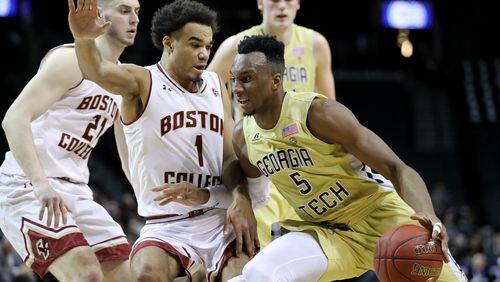Among the favorite talking points of Georgia Tech coach Josh Pastner is “get old and stay old.” He repeats it in interviews with such frequency that it would not be a surprise if Pastner said it in his sleep if he actually slept.
When viewed through that vision for his team, the disappointment of Pastner’s second season and its divergence from the Yellow Jackets’ surprising performance under his leadership in his first season makes sense. Former coach Brian Gregory bequeathed Pastner an old team, particularly at a critical spot, point guard. The roster was panned at the outset, but it set the stage for a magical season.
The Jackets this season were young and, in a sense, got even younger as the season went on. Add in injuries and off-court complications, and a season-ending record of 13-19 became the unsurprising outcome.
“Obviously, the season didn’t go the way anybody wanted it to on this team,” guard Josh Okogie said. “But it’s a learning lesson for everybody on this team, coaching staff, for me, seniors as they go off, freshmen returning, the new guys coming in.”
Over his final three seasons, point guard Jose Alvarado figures to become an increasingly effective player. He is quick on the dribble, accelerates quickly, has a decent 3-point shot and has a toughness that could rub off on teammates as his stature as a leader develops. Pastner went all in on Alvarado, playing him for 432 of a possible 445 minutes in his first 11 ACC games before the season-ending elbow fracture.
But, at least at this juncture, he is not the player that Josh Heath was last season as the Jackets’ point guard. Heath was not the scorer or rebounder that Alvarado is, but could do most everything else better, not surprising given that Heath was a senior with 82 games under his belt in his first three seasons. He communicated well, moved the ball and coordinated the defense.
Heath’s per-game assist/turnover ratio over the team’s final 23 games, after he moved into the starting lineup, was 5.1/2.7. Alvarado’s per-game ratio in ACC games this season was 2.7/2.9. While center Ben Lammers and Okogie were the stars of last year’s run to the NIT, Heath was the unsung coach on the floor.
Through no fault of his own, Alvarado hasn’t attained that level of play yet.
Beyond Heath and Alvarado, the differences in youth and experience in Pastner’s first two teams are striking.
Freshmen Evan Cole, Curtis Haywood, Moses Wright and Alvarado combined to play 31 percent of Tech’s minutes, and it might have been greater had Haywood stayed healthy. Last year, freshmen Justin Moore and Okogie contributed 24 percent of the minutes, and it could be easily argued that the quality of last year’s freshman minutes, particularly those played by Okogie, were superior in quality to this season’s.
Consider that Okogie gave Tech one of its best individual seasons by a freshman in school history, while Cole and Wright were put into a “redshirt” program because their playing-time chances seemed so limited before injuries pressed them into action.
Last year, scholarship juniors and seniors, not counting graduate transfers Kellen McCormick and Jodan Price, played 68 percent of the minutes. This year, not counting graduate transfer Brandon Alston, scholarship juniors and seniors received 36 percent of the playing time.
Last year, that translated into more quickly grasping and implementing what Pastner wanted and playing with maturity and an edge. Pastner’s vision for the team has been to develop freshmen and sophomores so they’ll be able to win games as juniors and seniors while keeping the pipeline stocked. Hence, “get old and stay old.”
As Pastner has said, Alvarado, Cole, Haywood and Wright will benefit greatly in seasons to come from the experience gained this season. But the value of their contributions in helping win games this season was mixed.
“Obviously, we had a lot more new guys on the team this year than last year,” Okogie said. “There’s so much you can tell them, so much you can say to them, but the biggest thing is letting them go through a season by themselves.”
And, even as Alvarado was not an equivalent replacement for Heath, he didn’t even finish the season, leaving the Jackets with lesser options for the final seven games of the season, five of them losses. Alvarado’s elbow injury was one of two season-ending injuries (Haywood suffered the other one, a stress reaction in his shin) and required Pastner to shift around his few remaining pieces, eventually settling on playing Tadric Jackson at the point, a job he took on with aplomb in the final games of his career.
Still, “it’s a recipe for disaster to play in the ACC without a point guard,” Pastner said.
Besides Haywood and Alvarado’s injuries, Lammers sprained his ankle in the second game of the season and wasn’t right for about three months. Pastner acknowledged that he probably should have rested Lammers and let him heal rather than to play him with limited agility and explosiveness.
Lammers’ points and rebounds per game and field-goal percentage in the first 27 games: 11.0/8.4/45.0.
The same averages in the last five games, when his ankle felt healthy again: 15.4/6.6/51.2.
“Obviously, I wish I was more healthy this entire season, but either way, I did some things that maybe not everyone anticipated from me or any kind of Georgia Tech player, so I’ve got to be proud of that,” Lammers said.
And, for good measure, mix in three NCAA suspensions, the resignation of assistant coach Darryl LaBarrie in the wake of a prolonged NCAA investigation into an alleged rules violation and his public estrangement with Ron Bell.
In that light, a fall from 21-16 to 13-19 – 2-8 against teams that were in the RPI top 50 after Wednesday’s games – isn’t confusing.
It’s not unreasonable to think that, with health and an absence of off-court complications, the record could have been flipped. But, as Lammers put it, “this is the end result. You kind of have to work with it at this point. I’m still proud of the way our team fought throughout this entire season. I can’t really be disappointed at all.”
About the Author







